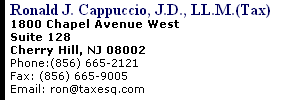|
Parents,
stepparents and other people raising children need to be
aware of a significant change in the way "qualifying
children" are defined under the tax law for the purpose
of claiming several benefits.
 |
|
INVESTORS:
Don't Forget Tax-Favored Treatment for Gains From
Broad-Based Equity Index Options
|
|
The
current federal income tax rates on long-term
capital gains are so low, you should generally try
to satisfy the more-than-one-year holding period
rule before selling appreciated securities held in
taxable investment accounts. That way, you’ll pay
no more than the 15 percent maximum federal rate
on long-term capital gains.
However,
you may not always invest for the long term. For
instance, you may sometimes speculate on stock
index movements by making short-term trades in
ETFs (exchange traded funds) like QQQ (which
tracks the NASDAQ 100 index) and SPDR (which
tracks the S&P 500 index). Of course, your
short-term ETF trading profits will be taxed at
ordinary income rates, which can be as high as 35
percent.
Fortunately,
a special taxpayer-friendly exception applies to
profits from trading in broad-based equity index
options. The tax law treats these broad-based
options as Section 1256 contracts. This is
good for your 2005 tax return, because gains and
losses from going long or short in Section 1256
contracts are automatically considered to be 60
percent long-term and 40 percent short-term.
(Source: Internal Revenue Code Section
1256(a)(3))
In other words, your
actual holding period for the option doesn’t
matter. The tax-saving result is that your 2005
short-term profits from trading in broad-based
equity index options will be taxed at a maximum
effective rate of only 23 percent [(60 percent
times 15 percent) plus (40 percent times 35
percent) equals 23 percent]. The effective tax
rate is even lower if you’re not in the top 35
percent bracket.
You
can trade broad-based equity index options that
track major stock indexes and major industry
sectors like oil, pharmaceuticals, defense, and
biotech.
|
A
qualifying child can enable a taxpayer to claim several
tax breaks, such as head of household filing status, a
dependency exemption, the child tax credit, the child
and dependent care credit and the earned income tax
credit. In the past, each of these items defined a
qualifying child differently, leaving many taxpayers
confused.
The Working Families Tax
Relief Act set a uniform definition of a qualifying
child, beginning with the 2005 tax year. This standard
definition applies to all five of the tax breaks listed
above, with each benefit having some additional
rules.
However, in the process of
standardizing the definition of a qualifying child, some
unexpected consequences have occurred. Some taxpayers
who could claim child-related tax breaks in the past are
no longer eligible and other people may benefit in ways
that Congress never intended.
In general, four
tests must be met in order to be a taxpayer’s qualifying
child:
- Relationship
– The child must be the taxpayer’s child or
stepchild (whether by blood or adoption), foster
child, sibling, stepsibling, or a descendant of one of
these.
- Residence
– The child must have the same principal
residence as the taxpayer for more than half the tax
year. Exceptions apply, in certain cases, for children
of divorced or separated parents, kidnapped children,
temporary absences, and for children who were born or
died during the year.
- Age
– The child must be under the age of 19 at
the end of the tax year, or under the age of 24 if a
full-time student for at least five months of the
year, or be permanently and totally disabled at any
time during the year.
- Support
– The child cannot provide more than one-half
of his or her own support for the year.
If a qualifying child is
claimed by two or more taxpayers in a given year:
- The child will be
the qualifying child of the parent.
- If more than one
taxpayer is the child’s parent, the qualifying child
goes to the one with whom the child lived for the
longest time during the year, or, if the time was
equal, the parent with the highest adjusted gross
income (AGI).
- If no taxpayer is
the child’s parent, the taxpayer with the highest AGI
gets to claim the qualifying child.
Here are a couple of
examples of taxpayers who could be affected by the
law:
Winner - An
over-age-19 child living in a parents' home could
potentially claim a younger brother or sister as a
qualifying child for purposes of the dependency
exemption, the child tax credit, and other benefits —
if the parents have income that is too high to benefit
from those tax breaks. This may be true even if
the older sibling provides no support to the younger
child, because the new law only requires that the
child not provide more than half of his or her
support. With the right set of circumstances, this
could benefit families with an older child living at
home and earning too much money to be claimed as the
parents' dependent. (Congress may amend the law in the
future to eliminate this.)
Loser
- A
taxpayer who lives with, and supports, a child who is
not his or her own, generally does not get tax
benefits for a qualifying child if he or she lives
with but is not married to the child's
parent.
As
noted above, each of the child-related tax breaks has
its own set of rules in addition to the four
qualification tests that must be met. If you are
supporting a child, your tax adviser can provide more
information in your situation.

|














